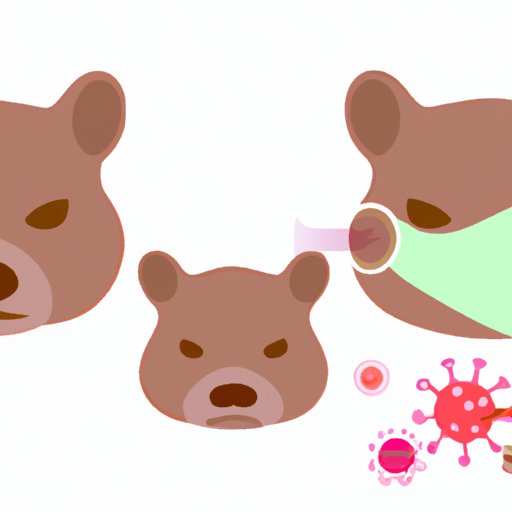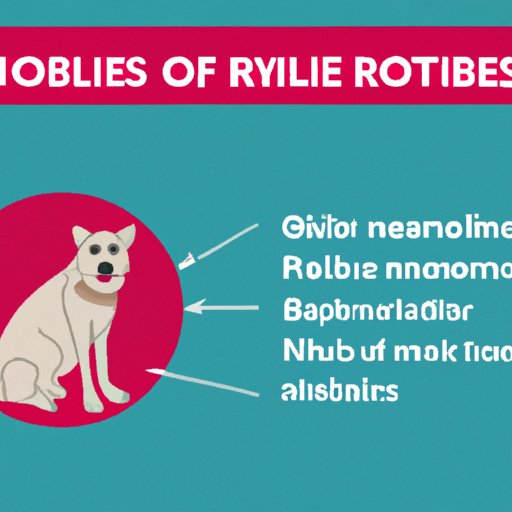
Introduction
Rabies is a deadly virus that can be transmitted to humans and animals through the bite or scratch of an infected animal. It’s important to recognize the symptoms of rabies early to ensure proper medical attention is sought. In this article, we’ll go over the common symptoms of rabies, how to identify them, and what steps you can take to protect yourself and your pets from getting infected.
Don’t Ignore These Signs: Common Symptoms of Rabies in Humans and Animals
The most common symptoms of rabies in both humans and animals are:
- Fever
- Headache
- Nausea and vomiting
- Agitation and restlessness
- Difficulty swallowing
- Excessive salivation
- Muscle weakness and spasms
- Paralysis
- Seizures
- Coma
If you or your pet are exhibiting any of these symptoms, seek medical attention immediately. Rabies is a serious illness that requires prompt treatment.
How to Identify Rabies Symptoms: A Comprehensive Guide
Rabies symptoms can manifest differently in different species, so it’s important to know what to look for. Here’s a more detailed breakdown of each symptom:
Fever
One of the earliest symptoms of rabies is a fever. This is a common symptom for many illnesses, so it’s important to be aware of other symptoms as well.
Headache
Headache is another early symptom of rabies. It may be accompanied by general malaise or fatigue.
Nausea and vomiting
As the virus progresses, nausea and vomiting may occur. This is often a sign that the virus has spread to the central nervous system.
Agitation and restlessness
Agitation and restlessness can manifest in both humans and animals. In animals, this may mean unusual behavior such as a docile animal becoming aggressive.
Difficulty swallowing
As the virus begins to affect the muscles, difficulty swallowing may occur. This can be dangerous if the individual becomes unable to drink fluids.
Excessive salivation
Excessive salivation is often one of the most noticeable symptoms of rabies in animals. The mouth may droop and drool excessively, and the individual may have difficulty closing their mouth.
Muscle weakness and spasms
Muscle weakness and spasms are common symptoms of rabies. Animals may have difficulty walking or standing, while humans may experience pain or convulsions.
Paralysis
Eventually, the virus can cause paralysis. This can be especially dangerous if the individual is unable to move necessary muscle groups such as those required for breathing.
Seizures
The virus can cause seizures as it progresses. These may occur in humans or animals.
Coma
In the later stages of the illness, the individual may become comatose.
If any of these symptoms are present, seek medical attention immediately.
Rabies Symptoms You Need to Know: Protecting Yourself and Your Pets
Preventing rabies is the best way to protect yourself and your pets from the disease. Here are some tips to help keep you safe:
- Vaccinate your pets against rabies
- Avoid contact with wild or stray animals
- Keep your pets on a leash or in a fenced area to prevent them from coming into contact with other animals
- Report any animal bites to your local animal control agency
- Wash animal bites or scratches thoroughly with soap and water and seek medical attention immediately
By taking these precautions, you can reduce your risk of getting rabies.
From Fever to Aggression: Understanding the Range of Rabies Symptoms
Rabies symptoms progress over time, and can differ depending on the strain of the virus. Some strains of rabies may cause symptoms to appear more quickly or aggressively than others.
The symptoms listed above may appear in any order. In some cases, symptoms may progress quickly while in other cases, the progression may be slower. It’s important to be vigilant and seek medical attention if any symptoms are present.
The Early Warning Signs of Rabies: Recognizing the Disease in People and Pets
The early warning signs of rabies may include:
- Fever
- Headache
- General malaise or fatigue
- Changes in behavior, such as restlessness or aggression
- Excessive licking or biting at the site of a wound
- Difficulty swallowing
- Excessive salivation
These symptoms may appear within the first few days of infection. It’s important to seek medical attention immediately if any of these symptoms are present.
When to Seek Medical Help for Rabies: Understanding the Symptoms
If you suspect you may have been exposed to the rabies virus, seek medical attention immediately. Getting treatment early is crucial for successful treatment.
To diagnose rabies, a doctor will typically look for symptoms of the illness, as well as perform tests such as a spinal tap. Treatment for rabies often involves a course of injections to help the body fight off the virus.

Living with Rabies: Coping with the Diagnosis and Managing Symptoms
Unfortunately, there is no cure for rabies once symptoms have appeared. Treatment usually focuses on managing symptoms and making the individual as comfortable as possible.
If you have been diagnosed with rabies, your doctor will work with you to help manage your symptoms and provide support during this difficult time.
Conclusion
Rabies is a serious illness that can be fatal if left untreated. By recognizing the symptoms of the virus and taking steps to prevent infection, you can reduce your risk of contracting the disease. If you suspect you may have been exposed to rabies, seek medical attention immediately.





